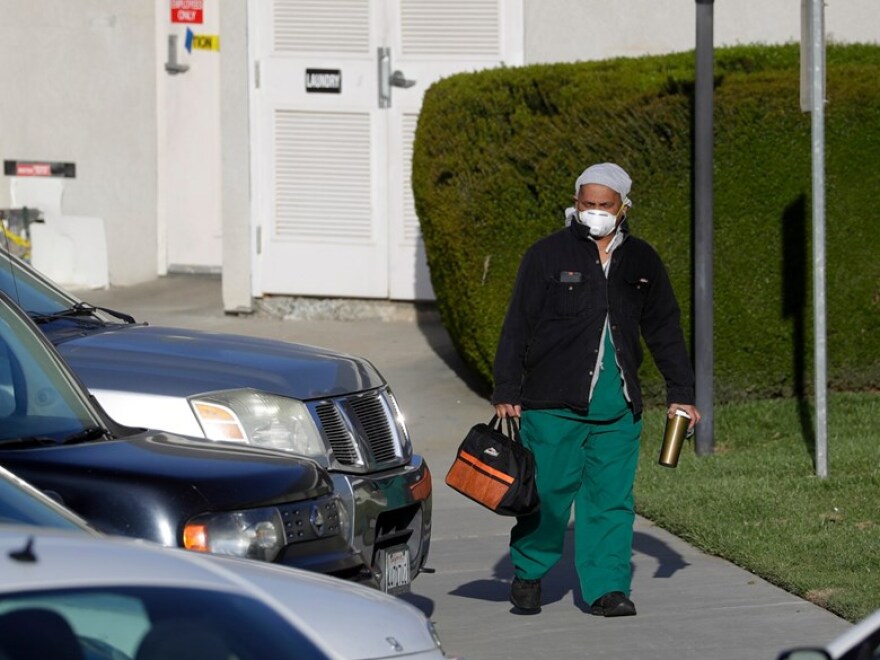Californians who are looking for in-home care for elderly or disabled loved ones this holiday season may have a difficult time finding help.
Experts and home care agencies say a longstanding shortage of in-home care providers has been exacerbated by the COVID-19 pandemic.
“We’re getting clients, but getting caregivers to come in and take care of those clients has been very difficult,” said Tracy Steuckrath, client services manager for Visiting Angels, a home care agency in Sacramento.
“We are unable to take care of the people who are in the greatest need ... They find themselves bouncing from agency to agency trying to find [a caregiver] that can be consistent.”
In-home caregiving presents unique risks during a pandemic. It can require bathing, feeding and other tasks that are impossible to do from six feet away. Steuckrath says there are certain clients, such as those with dementia or hearing problems, who ask their caregivers not to wear masks.
At some home care agencies workers see multiple clients, which could potentially spread the virus between homes. And some home care providers also work in skilled nursing facilities, where COVID-19 outbreaks have been frequent.
Henry Stern’s mother-in-law was in a skilled nursing facility when the pandemic started. But the Los Angeles-area state senator said he and his wife became anxious about the risk.
“We were still getting a text message every day, every other day, of ‘this many new patients have been infected, here’s another worker who’s been infected,'” he said. “Every time the text comes in your heart sinks, ‘cause you feel like you’re rolling the dice with somebody you love, every day.”
So in June, they decided to bring her home — but they needed help. Stern says they called all over to try to hire a caregiver, but either the agencies didn’t have someone available, or the options were too expensive.
“We were calling around, hitting brick walls for a while,” he said.
Ultimately they were able to get about eight hours of care covered a day, but Stern says his mother-in-law needs someone around the clock. So they decided to check her back into the nursing home they pulled her out of.
“We only lasted about three weeks, and sort of just had to make this weird financial and moral decision, to say ‘we know there are still risks, but we’ve gotta send her back',” he said.
Joanne Spetz researches the health care workforce at the University of California, San Francisco. A study she authored found California is facing an estimated shortage of 200,000 home care aides.
“Home care workers tend to have low wages, and with the extra risk associated with the pandemic, it is likely that some have decided it’s not worth the risk,” she wrote in an email. “They also often don’t get sick leave, which is another deterrent.”
During the COVID-19 crisis, labor unions representing home health workers have written to the stateasking for income support, health benefits, sick leave and unemployment insurance. They’ve also been raising the alarm about the need for protective equipment, sanitation supplies and free testing for these employees.
Christina Irving is client services director at Family Caregiver Alliance, a Bay Area organization that provides support to home care agencies and individual caregivers. She says they’re hearing a lot of concerns about recruitment being slow during the pandemic, and the effect that has on families.
“We’re seeing some families who are having to provide more of that care themselves, for longer, which leads to potentially more burnout and stress for family caregivers,” she said. “And potentially even caregivers who are having to leave the workforce because they can’t find anybody else to come in while they go to work.”
Client demand usually increases in November and December, said Steuckrath at Visiting Angels.
“Kids come home for the holidays … they see mom and dad have declined in a way they didn’t imagine, and then we get a phone call,” she said. “Without the staff to appoint to these families, I’m not sure what we’re going to do.”
There’s a push to get private insurance companies to cover more in-home care, and to increase the breadth of services available through Medi-Cal, the state’s low-income health program.
Here is some guidance and information for families looking for in-home care:


